Category Archives for Sketching
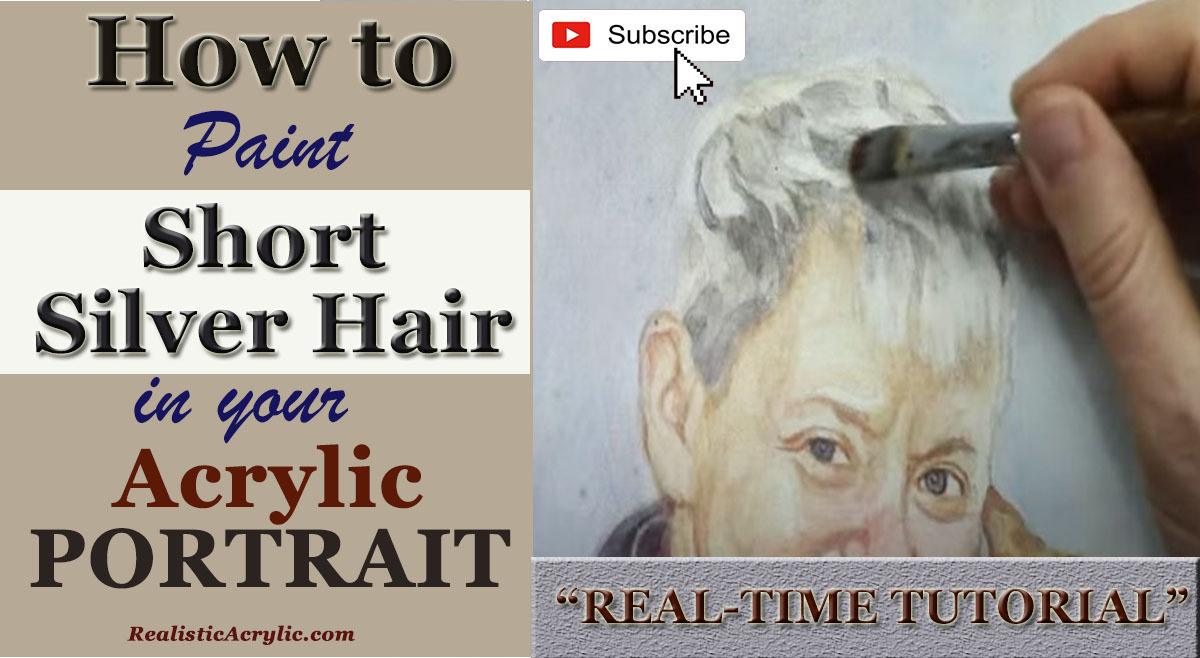
How to Paint Short Silver Hair in your Acrylic
Discover the secrets to painting realistic short silver hair using the acrylic glazing technique for depth, vibrance, and seamless blending.
Painting realistic short silver hair in acrylic can seem challenging, but with the right techniques, it becomes manageable and rewarding. In this tutorial, I will guide you step-by-step on how to apply the acrylic glazing technique to capture the softness, shine, and texture of silver hair. Whether you’re a beginner or an experienced artist, mastering this technique will help you create stunning portraits with depth and vibrance. We will focus on blending shades, adding highlights, and building subtle nuances for a natural-looking effect.
Understanding Acrylic Glazing for Hair
Acrylic glazing is an essential technique for adding layers of semi-transparent color over your base. By layering different shades, you can achieve depth and a lifelike sheen, perfect for capturing the essence of silver hair. Instead of trying to nail every detail in one go, glazing allows you to build the portrait gradually, adding complexity with each new layer.
Tips for Acrylic Glazing:
- Use a mix of acrylic matte medium with your paint to create a smooth, translucent layer.
- Work with a soft, fine brush to ensure smooth transitions between shades.
- Build layers slowly, allowing each one to dry before adding the next for better control over color depth.
Choosing Your Color Palette
When painting short silver hair, selecting the right color palette is essential. Although silver is often seen as a neutral tone, it actually contains a mixture of hues such as cool blues, grays, and even some warmer tones to reflect light.
For this tutorial, the palette includes:
- Titanium White: For bright highlights and reflective areas.
- Burnt Umber: To add warmth and contrast in the shadows.
- Raw Umber: For mid-tones and foundational shading.
- Ultramarine Blue: Helps cool down areas and enhance the silver effect.
- Alizarine Crimson: Adds subtle warmth and depth.
Tip: Always test your color combinations on a palette before applying them to the canvas. Mix small amounts to see how they interact under different lighting conditions.
Step-by-Step Guide to Painting Short Silver Hair
1. Start with the Underpainting
Before you apply any details, establish a base using a neutral underpainting. This is where you define the overall shapes and contours of the hair. For silver hair, use a mix of raw umber and titanium white to sketch out the general flow and placement of the hair strands. Remember to think of hair not as individual strands but as groups of shapes and shadows.
Technique Tip: Use a soft filbert brush to apply the underpainting in smooth, broad strokes. This will help create a soft foundation for the subsequent layers.
2. Building Mid-Tones with Glazing
Once the underpainting is dry, begin adding mid-tones using the acrylic glazing technique. Mix ultramarine blue and burnt umber with a small amount of matte medium to create a semi-transparent glaze. This mixture will give your hair a cool, metallic feel. Apply the glaze over the darker areas, building the transition from shadow to light.
Technique Tip: Apply the glaze in thin layers, allowing each coat to dry before adding another. This will help create depth and prevent the colors from becoming too muddy or opaque.
3. Adding Highlights
Silver hair catches light in unique ways, often appearing more reflective than other hair colors. To capture this, mix titanium white with a tiny bit of raw umber and alizarine crimson. Use this mixture to gently highlight the areas where the light naturally hits the hair, such as the crown of the head and the edges of the strands.
Tip: Use a small round brush for highlights to add fine, delicate lines. Blend the edges of the highlights into the mid-tones to avoid harsh transitions.
4. Deepening the Shadows
Shadows in silver hair help give it volume and shape. For this, mix a slightly darker glaze with more burnt umber and ultramarine blue. Focus on the areas where the hair overlaps or falls into deeper recesses, such as around the ears or where the hair gathers near the scalp.
Technique Tip: When applying shadows, think of the hair in terms of mass rather than individual strands. Keep the shapes soft and avoid over-defining every strand to maintain a natural look.
5. Refining the Details
As you continue building up the layers of glazes, the hair will start to take on a more realistic appearance. At this stage, focus on refining small details, such as the subtle shifts in tone and light across the hair. Add final touches by applying thin, semi-transparent layers of titanium white mixed with matte medium for the brightest highlights.
Tip: Don’t overwork the painting. Let some of the earlier layers show through to enhance the depth and complexity of the hair.
Common Mistakes to Avoid
- Overloading the Brush: Avoid applying too much paint at once. This can make your glaze too thick and result in harsh lines instead of smooth transitions.
- Skipping the Drying Time: Acrylic paint dries fast, but it’s important to let each layer fully dry before applying the next. Rushing this process can lead to muddy colors and a lack of definition.
- Neglecting the Highlights: For silver hair, highlights are crucial. Make sure to spend enough time building up the light areas to capture the reflective quality of the hair.
Final Thoughts
Painting short silver hair in acrylic requires patience and a careful approach, but the results are worth the effort. By using the glazing technique, you can achieve depth, softness, and shine that will make the hair in your portrait come to life. Whether you’re painting a portrait of a loved one or a professional commission, these techniques will help you capture the unique beauty of silver hair with confidence.
Remember, as with all acrylic painting techniques, practice makes perfect. So, don’t be afraid to experiment with different glazes, brushes, and colors to find what works best for you.
Conclusion
When mastering the art of painting short silver hair is a valuable skill for any portrait artist. With then the right use of acrylic glazing, attention to color blending, and proper brush techniques, you can create stunning, realistic results. By following these steps and tips, you will develop the confidence to tackle even the most challenging portrait hair details.
Keep practicing, and soon, painting silver hair will become second nature!
If you’re looking for more instructional videos on how to improve your acrylic painting, visit www.realisticacrylic.com for more tutorials and check out my free courses here. .
- How to Paint Foliage Using the Acrylic Glazing Technique
- How to Trace for an Accurate Portrait Sketch
- How to Paint Realistic Eyes in Your Acrylic Portrait
- How to Add Raw Umber Dark & Ultramarine Blue to Your Portrait
- How to Make Your Own Raw Umber Dark
- How to Paint Realistic Trees & Grass in Your Acrylic
- How to Block In Skin Tone Values Using Glazing Technique
- How to Paint Vibrant Reds in Your Acrylic Portrait
- How to Glaze Background Colors & More Acrylic Portrait
- How to Paint White Clothing in Your Acrylic Portrait
- How to Easily Transition from a Sketch to a Painting
- How to Block In Shading & Skin Tones in Your Acrylic
- How to Build Up Color on Acrylic Pet Portrait
- How to Build Up Form on Clothing with Acrylic
- How to Paint Dark Clothing Using Acrylic Glazing Technique
- How to Paint a 24 x 30 Acrylic With 30 People
- How to Do Smooth Shading with Acrylic
- How to Sketch an Acrylic Portrait with a Grid
Read more about how to paint a portrait that you can surely be proud of!
I’d love to hear your thoughts on this video. Please share it with your friends and family. Let me know if you have any further questions. I’ll greatly help you.
If you’d like to learn more, sign up for my free email tips and video class today.
Learn How to Paint Acrylic Portraits With My Free Mini-Video Course!
Thank you so much for taking the time to read this tutorial and watch the video. That means a lot to me. I hope you find it very helpful in your portrait painting.
Yours for Better Portraits,

P.S. Did you find this post helpful or encouraging? If so, send it on ahead! Let others know with the share buttons below. I’d love to hear your comments. Thank you so much! Also, do you have a question on acrylic portrait painting you’d like answered? Let me know, and I’d be happy to help!
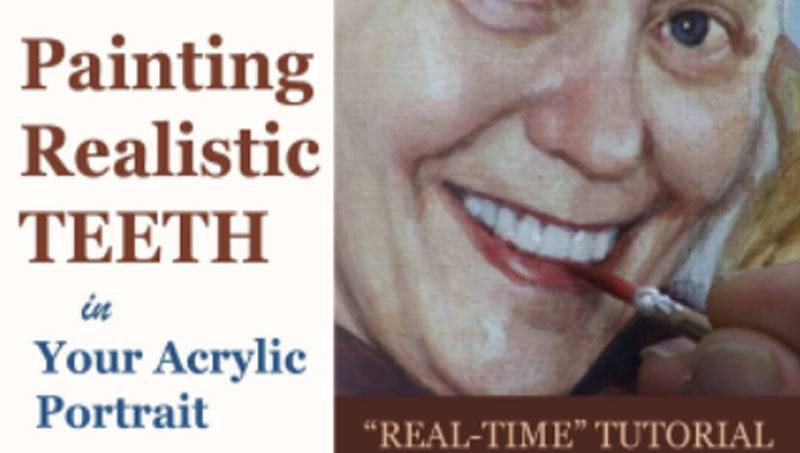
How to Refine the Shape of Teeth in Your Acrylic Portrait
Master the subtle art of refining teeth in your acrylic portraits for greater accuracy and lifelike results.
Introduction: Why Refining Teeth Matters in Portraiture
When capturing the likeness of a subject in portraiture can hinge on seemingly minor details. One such detail is the refinement of teeth. It may seem small, but accurately painting teeth, especially the bottom ridges, plays a critical role in rendering a realistic, lifelike portrait. Subtle nuances in the shape of the teeth can dramatically alter the facial expression and overall appearance of the subject.
In this tutorial, you will learn how to refine the shape of teeth using acrylics. We’ll focus on the process of painting the subtle bumps on the bottom of the teeth, ensuring that your portraits achieve a more polished and authentic result.
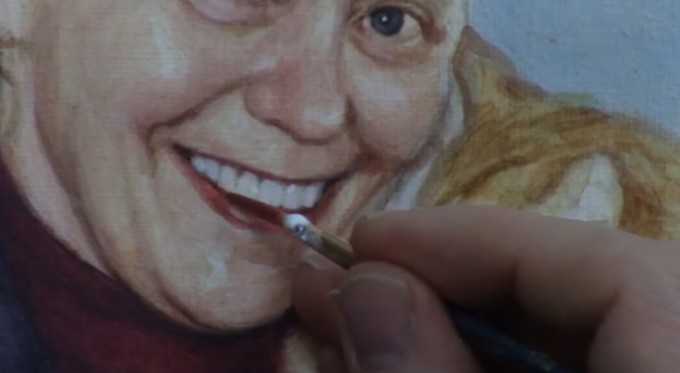
Step 1: Analyzing the Reference Photo
Before picking up your brush, it’s important to thoroughly examine your reference photo. The shape and position of the teeth vary significantly from person to person, and replicating these unique traits is key to capturing the subject’s likeness.
Tip: Zoom in on your reference photo to observe the details of the teeth, especially the bottom edge where subtle bumps and curves may appear. This is where the separation between the teeth and the gums becomes more pronounced.
Technique: Keep the focus on how the light hits the edges of the teeth and gums, as this will guide you in applying shadows and highlights.
Step 2: Mixing the Right Colors
In this next phase, you’ll begin by mixing a base color that is slightly darker than the lip color to define the bottom edge of the teeth. To create this mix, combine the following colors:
- Pyrolle Orange (also known as Organic Orange)
- Alizarine Crimson
- A small amount of Raw Umber Dark
These colors produce a rich, reddish hue that closely matches the natural coloration around the teeth and lips. If needed, adjust the mix by adding a touch of titanium white to lighten the color without losing its vibrancy.
Tip: Use a white card to test your color before applying it to the painting. This will allow you to see how it contrasts with your existing skin tones and lips.
Technique: Apply the color in thin layers, pulling up toward the gums to create the natural transitions between the teeth, gums, and lip area. It’s important to paint with precision to avoid making the teeth appear too long.
Step 3: Adding Subtle Details
To refine the teeth further, you’ll need to add delicate shadows and highlights. Start by mixing a darker color for the shadows:
- Ultramarine Blue
- Alizarine Crimson
- A bit of Raw Umber Dark
This creates a deeper, more muted tone that will help add definition to the bottom of each tooth. You can use this color to subtly separate the teeth from one another.
Tip: Avoid making the lines between the teeth too dark or harsh. The goal is to create a natural look, not to outline each tooth dramatically. A soft, gradual transition between light and dark will ensure that the teeth appear realistic.
Technique: Apply this darker shade right below the teeth, particularly where the bottom row meets the gums. Remember, each tooth has slight variations in shading, so pay attention to your reference photo to determine where the shadows fall.
Step 4: Softening Edges for Realism
Once the main colors and shadows have been applied, it’s time to refine the edges of the teeth. You can soften the hard edges by blending the colors gently where the teeth meet the gums and where the light hits the teeth.
Mix a small amount of titanium white with raw umber dark to create a subtle highlight color. Apply this along the top of the teeth where light would naturally reflect off the enamel.
Tip: Don’t overdo the highlights. The key is to add just enough light to define the shape of the teeth without making them look too bright or artificial.
Technique: Lightly brush over the teeth with small, upward strokes. This will give the teeth a more rounded, natural appearance and help avoid a “flat” look.
Step 5: Fine-Tuning the Details
Now that the main shapes and shadows are in place, it’s time to fine-tune the details. Look at the spaces between the teeth and make any necessary adjustments to ensure they aren’t too close together or too far apart. Add any final touches of shadow or highlight that might be missing.
Tip: Step back from your painting occasionally to check how the teeth fit into the overall portrait. Sometimes, it’s easier to notice small errors or imbalances when viewing the piece from a distance.
Technique: Use a small, fine-tipped brush to add the final strokes of detail. These small refinements make a significant difference in the realism of the portrait.
Why This Process Matters
Refining the shape of teeth is one of those small but crucial steps in portrait painting. When done right, it adds to the likeness of the subject and creates a more lifelike portrait. If the teeth are too bright, too long, or inaccurately shaped, it can detract from the overall piece.
By using the techniques outlined above carefully mixing colors, softening edges, and adding subtle highlights and shadows you will ensure that your acrylic portrait looks polished and professional.
Conclusion: Elevate Your Portrait with Refined Details
As you can see, refining the shape of teeth in an acrylic portrait isn’t about painting them with strict lines and bright colors. Instead, it’s about creating soft transitions between light and shadow, observing your reference closely, and painting with patience.
With these techniques, your portraits will capture the likeness and subtle beauty of your subjects, ensuring that every detail, no matter how small, contributes to the overall realism.
If you found this guide helpful, be sure to explore more tutorials on realisticacrylic.com. Whether you’re just starting or looking to refine your skills further, you’ll find valuable resources to help you paint portraits you can be proud of.
Final Tips for Refining Teeth in Acrylic Portraits
- Use small, precise brushes for the detailed work around the teeth and gums.
- Layer your colors rather than applying too much paint at once. Thin layers create depth.
- Test your colors on a white card to ensure they blend naturally with surrounding skin tones.
- Soften hard edges to avoid a flat, unrealistic look.
- Check your reference photo frequently to ensure you’re capturing the unique shape and characteristics of your subject’s teeth.
For further resources and guides, visit realisticacrylic.com and check out my free courses to enhance your acrylic painting journey.
- How to Paint Foliage Using the Acrylic Glazing Technique
- How to Trace for an Accurate Portrait Sketch
- How to Paint Realistic Eyes in Your Acrylic Portrait
- How to Add Raw Umber Dark & Ultramarine Blue to Your Portrait
- How to Make Your Own Raw Umber Dark
- How to Paint Realistic Trees & Grass in Your Acrylic
- How to Block In Skin Tone Values Using Glazing Technique
- How to Paint Vibrant Reds in Your Acrylic Portrait
- How to Glaze Background Colors & More Acrylic Portrait
- How to Paint White Clothing in Your Acrylic Portrait
- How to Easily Transition from a Sketch to a Painting
- How to Block In Shading & Skin Tones in Your Acrylic
- How to Build Up Color on Acrylic Pet Portrait
- How to Build Up Form on Clothing with Acrylic
- How to Paint Dark Clothing Using Acrylic Glazing Technique
- How to Paint a 24 x 30 Acrylic With 30 People
- How to Do Smooth Shading with Acrylic
- How to Sketch an Acrylic Portrait with a Grid
Read more about how to paint a portrait that you can surely be proud of!
I’d love to hear your thoughts on this video. Please share it with your friends and family. Let me know if you have any further questions. I’ll greatly help you.
If you’d like to learn more, sign up for my free email tips and video class today.
Learn How to Paint Acrylic Portraits With My Free Mini-Video Course!
Thank you so much for taking the time to read this tutorial and watch the video. That means a lot to me. I hope you find it very helpful in your portrait painting.
Yours for Better Portraits,

P.S. Did you find this post helpful or encouraging? If so, send it on ahead! Let others know with the share buttons below. I’d love to hear your comments. Thank you so much! Also, do you have a question on acrylic portrait painting you’d like answered? Let me know, and I’d be happy to help!
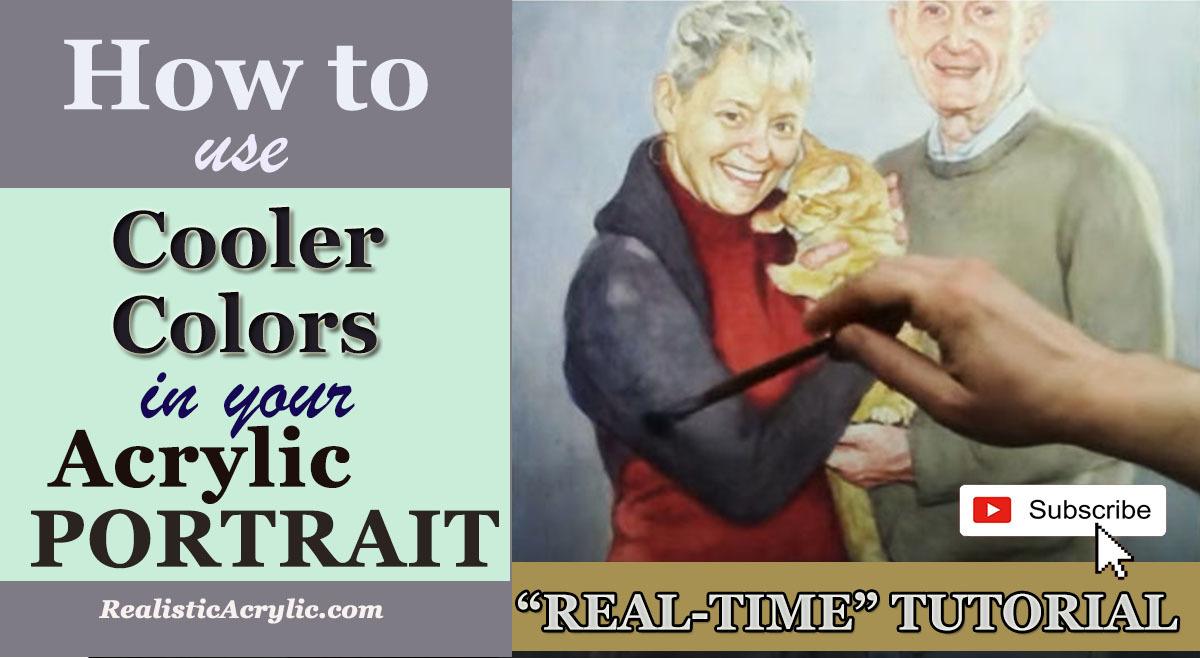
How to Use Cooler Colors in Your Acrylic Portrait
Learn the art of using cooler tones for shadows and contrast to bring depth and realism to your acrylic portrait painting
Introduction
In acrylic portrait painting, the choice of colors can dramatically impact the realism of your artwork. One technique that often gets overlooked is the use of cooler colors, particularly for creating shadows and depth. Instead of relying on darker versions of the same color or black, incorporating cooler hues like blue and gray can bring out more natural and nuanced details in your portraits. In this tutorial, we will explore how to use cooler colors, specifically in shadows and darker areas, to enhance the depth and contrast of your acrylic portraits.
The Role of Cooler Colors in Acrylic Portraits
Cooler colors, such as blues and grays, are ideal for creating subtle and realistic shadows in portrait painting. Because by using cooler tones in shadowed areas, you avoid overly vibrant or muddy colors that can flatten the subject. Cooler shades also help control the brightness in darker values without overpowering the other tones in your painting. Then shadows should never be too warm, as they might disrupt the balance of the painting. Instead, by adding cooler hues, you’ll create a sense of depth and dimensionality that feels natural.
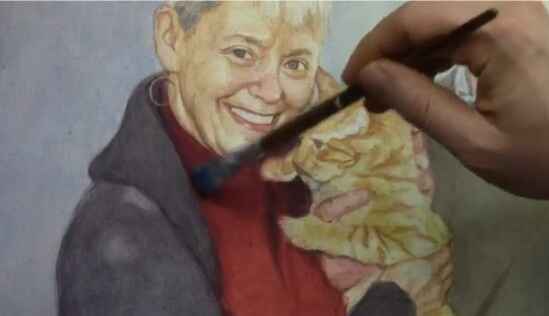
Why Not Use Black?
It’s tempting to use black or simply darker shades of your base color for shadows. However, this approach often makes shadows look too harsh or unnatural. Instead, combining cooler colors like ultramarine blue mixed with brown tones, such as raw umber, produces a more harmonious, darker value. This method lets you keep the integrity of your portrait’s vibrancy while still defining areas of shade.
Techniques for Using Cooler Colors
1. The Glazing Technique
Glazing is a technique where thin, translucent layers of paint are applied over an existing layer to adjust the hue and value without covering the underlying color completely. In this video, we use ultramarine blue mixed with raw umber dark and matte medium to create a translucent shadow that gently cools the red clothing in the portrait.
- Materials Needed:
- Ultramarine blue
- Raw umber dark
- Matte medium
By using this combination, you get a subtle cooler tone that darkens the red areas without losing the warmth of the original color. The matte medium ensures that the paint layer remains translucent, allowing the original red to shine through but with a softened, shadowed effect. This technique works well for shading clothing, hair, and other elements in a portrait where subtle shadows enhance realism.
2. Dry Brush Technique for Fine Shading
The dry brush technique, as shown in the video, allows for fine-tuning of cooler colors in areas where you want to add texture or smooth gradients. By lightly dragging the nearly dry brush over the surface, you can blend colors gently and gradually. This is particularly effective for textured clothing or rough surfaces where you need shadows to add realism without overpowering the light source.
- Steps to Achieve the Effect:
- Dip your brush in the paint mixture and then wipe off most of it, leaving only a trace amount on the bristles.
- Lightly brush over the desired area, letting the minimal paint layer gradually blend in.
- Continue adding more layers as needed, allowing the painting to build up gradually.
The dry brush technique works best for elements like clothing or textured surfaces in your portrait, where there’s room for a more natural, rough finish. It adds depth without losing the existing colors underneath.
3. Layering Cool Tones
When you apply cooler tones, especially when using the glazing technique, you can layer them to achieve depth. In the video, I use the bluish-gray color not only on the red sweater but also on the surrounding darker areas of the portrait. By layering these cooler tones, you can transition between shadows smoothly, unifying the portrait without jarring contrasts. Each glaze or layer adds a subtle gradation, which makes the painting feel more cohesive.
Where to Use Cooler Colors in a Portrait
- Shadows Under the Chin:
Cooler colors like ultramarine blue mixed with raw umber create a natural shadow under the chin without overpowering the light source. The coolness of the blue offsets the warmth of skin tones, providing a balanced and realistic shadow. - Clothing Shadows:
As demonstrated in the video, applying a cooler glaze to the darker parts of clothing can reduce the vibrancy of warm colors while preserving their richness. This keeps the fabric from looking too harsh or over-saturated in shadowed areas. - Hair and Other Textured Areas:
The dry brush technique works particularly well in areas where texture is important, such as hair. By using cooler tones and a dry brush method, you can add subtle highlights and shadows to hair, enhancing its dimensionality.
Benefits of Using Cooler Colors
- Increased Depth and Dimension:
Cooler colors, particularly in shadows, add depth and realism to a portrait. They allow shadows to recede into the background while keeping the subject looking three-dimensional. - More Natural Shadows:
Rather than simply darkening a color with black or gray, using cooler tones helps create more natural shadows. This results in smoother transitions between light and dark areas. - Control Over Vibrancy:
Cooler tones help reduce the intensity of vibrant colors, especially in shadowed areas, giving your painting a more balanced and professional look.
Tips for Success
- Experiment with Ratios:
The ratio of ultramarine blue to raw umber can be adjusted depending on the desired level of coolness in your shadows. For darker areas, use more blue and less umber to deepen the shadow. - Build in Layers:
Always work in layers when using cooler colors. Apply a thin glaze, let it dry, and then build up the color gradually. This prevents the painting from becoming too dark or muddy. - Use Matte Medium:
Matte medium helps maintain the translucency of your paint layers, allowing you to adjust the color and value without losing the underlying colors. It’s crucial when applying cool tones, especially over warm areas.
Conclusion
Using cooler colors in your acrylic portrait can make all the difference when it comes to creating realistic shadows, depth, and contrast. Techniques like glazing and dry brushing with cooler tones such as ultramarine blue and raw umber dark allow you to darken areas without compromising the vibrancy and balance of your painting. If you’re looking to improve your portrait painting skills, remember that shadows are just as important as highlights—and cooler tones are your secret weapon for mastering them.
For more tutorials on acrylic painting techniques, check out realisticacrylic.com, where you can access free tips, tutorials, and classes to enhance your artistic journey.
- Adding highlights to your acrylic painting
- 5 Excellent Reasons to Use Aluminum Foil
- Paint Realistic Wrinkles in Acrylic
- Painting Clothing in an Acrylic Portrait
- Paint a Cloudy Sky Acrylic
- How to add Semi-Opaque Highlights
- How to Enhance the Contrast in Your Acrylic
- How to Add Glaze to Your Acrylic Painting
- Paint Realistic Reflections on Eyeglasses in an Acrylic Portrait
- Build Up Depth on Your Acrylic Portrait Backgrounds
- How Do You Do Layers With the Glazing Technique?
- Learn How to Paint Wrinkles in Acrylic
Read more about how to paint a portrait that you can surely be proud of!
I’d love to hear your thoughts on this video. Please share it with your friends and family. Let me know if you have any further questions. I’ll greatly help you.
If you’d like to learn more, sign up for my free email tips and video class today.
Learn How to Paint Acrylic Portraits With My Free Mini-Video Course!
Thank you so much for taking the time to read this tutorial and watch the video. That means a lot to me. I hope you find it very helpful in your portrait painting.
Yours for Better Portraits,

P.S. Did you find this post helpful or encouraging? If so, send it on ahead! Let others know with the share buttons below. I’d love to hear your comments. Thank you so much! Also, do you have a question on acrylic portrait painting you’d like answered? Let me know, and I’d be happy to help!
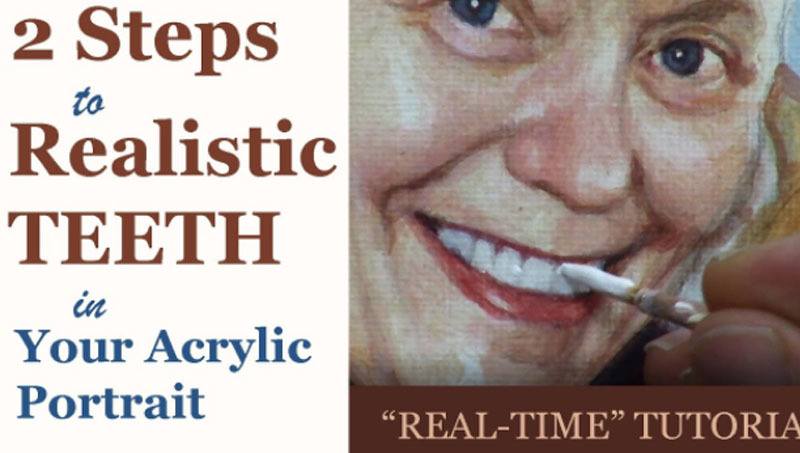
2 Steps on How to Make Teeth More Realistic
Learn how to add realistic depth and dimension to teeth in your acrylic portraits using these simple but effective techniques.
When painting an acrylic portrait, one of the areas that often challenges artists is getting the teeth to look realistic. Many artists fall into the common trap of painting teeth flat white, which detracts from the lifelike quality of a portrait. Teeth, however, are far from being a pure white color. In this guide, you’ll learn two simple yet effective steps that will elevate your skills in painting teeth, making them appear more realistic and natural.
Step 1: Proper Shading – Teeth Are Not White
One of the most frequent mistakes made when painting teeth is assuming they are stark white. In reality, teeth are often a light shade of gray or slightly off-white. In fact, if you compare teeth to a pure white object, you’ll notice they are significantly darker. Painting teeth flat white can give your portrait an artificial look and flatten the depth of the face.
To ensure you are capturing the right tone, use a white card to measure the value of your teeth compared to the background of your reference photo. When you observe closely, you’ll find that teeth have more of a grayish hue. By painting the teeth just a little darker than pure white, you create a realistic foundation that allows you to build up detail.
Here’s how you can achieve this:
- Mix titanium white with a small amount of raw umber dark and ultramarine blue to create a subtle grayish hue. This will be your base color for shading the teeth.
- Apply thin layers, blending the paint carefully, to ensure a smooth transition. The blend should not be too dark, but noticeably darker than pure white.
- To add more depth, mix a bit of matte medium into the paint. Matte medium helps thin the acrylic paint without compromising its color, allowing you to create soft, seamless shading that brings out the three-dimensional quality of the teeth.
By following these steps, you are creating the necessary contrast between the teeth and the bright highlights that will come in the next step.
Tip: Focus on the Surrounding Shadows
Shadows play an important role in shaping the teeth. Gums and lips often cast subtle shadows over teeth, making the edges slightly darker. Pay attention to these areas, especially around the perimeter of the teeth, to enhance the sense of depth. Remember, teeth are curved objects; shading on one side, while leaving the other lighter, will make them appear more dimensional.
Step 2: Adding Realistic Highlights – Bring the Teeth to Life
Once you’ve laid down the correct base color for the teeth, the next step is to add realistic highlights. These highlights are small but essential details that bring the teeth to life and make them look natural.
Teeth often have tiny reflections of light in certain areas, depending on the lighting in your reference photo. These highlights can be found along the tops of the teeth or on the edges where they catch the light the most. Here’s how you can effectively apply them:
- Use titanium white for these highlights. Unlike the shading, the highlights should be pure white, but use them sparingly to avoid an unnatural appearance.
- With a size 2 liner brush, carefully paint small pinpoint highlights in the appropriate spots, as seen in your reference image. The upper teeth often have highlights near the top, close to where the lips meet the teeth.
- After applying the highlights, blend them gently into the surrounding areas to avoid hard, distracting lines. The goal is to create a soft transition between the shaded and highlighted areas.
If the highlights appear too stark, you can modify the tone by adding a touch of indian yellow to warm them up. By warming the highlights, you mimic the natural hue of teeth, which tend to reflect a warmer tone due to their interaction with light and surrounding skin tones.
Tip: Be Subtle with Separation Lines
While teeth have visible separation lines, especially in close-up portraits, these lines should not be harsh. Use very faint lines to delineate individual teeth. A common mistake is making the lines too bold, which can give the teeth an outlined, cartoonish appearance. The size 2 liner brush is ideal for lightly sketching in these lines, but ensure they are soft enough to blend in with the rest of the portrait.
Additional Techniques to Improve Realism
1. Use Glazing for Depth
To create even more depth and nuance in the teeth, consider using a glazing technique. A glaze is a thin, translucent layer of paint that allows underlying layers to show through, creating a sense of depth.
- Mix a small amount of matte medium with your base gray color and apply it lightly over the teeth, focusing on areas that need more depth, such as the sides or lower parts of each tooth.
- This glazing technique allows you to build up subtle layers, increasing the realistic appearance of your portrait.
2. Pay Attention to Tooth Shape and Size
Not all teeth are the same size or shape, and these variations should be reflected in your painting. The front teeth are typically larger, while the ones on the sides taper off. Make sure to study your reference photo closely and adjust the size and shape of each tooth accordingly. This attention to detail will make your portrait look more realistic and proportional.
Conclusion
Getting the teeth right in an acrylic portrait is an essential step toward achieving realism. By shading the teeth a few tones darker than pure white and adding subtle highlights in the right spots, you can dramatically improve the lifelike quality of your portraits. Using techniques like glazing and paying attention to tooth shape will further enhance the overall effect. Follow these two steps carefully, and you’ll be well on your way to mastering the art of painting realistic teeth in acrylics.
With patience and practice, you’ll see improvements in your portrait painting skills, and your work will stand out for its lifelike qualities.
For further resources and guides, visit realisticacrylic.com and check out my free courses to enhance your acrylic painting journey.
- Adding highlights to your acrylic painting
- 5 Excellent Reasons to Use Aluminum Foil
- Paint Realistic Wrinkles in Acrylic
- Painting Clothing in an Acrylic Portrait
- Paint a Cloudy Sky Acrylic
- How to add Semi-Opaque Highlights
- How to Enhance the Contrast in Your Acrylic
- How to Add Glaze to Your Acrylic Painting
- Paint Realistic Reflections on Eyeglasses in an Acrylic Portrait
- Build Up Depth on Your Acrylic Portrait Backgrounds
- How Do You Do Layers With the Glazing Technique?
- Learn How to Paint Wrinkles in Acrylic
Read more about how to paint a portrait that you can surely be proud of!
I’d love to hear your thoughts on this video. Please share it with your friends and family. Let me know if you have any further questions. I’ll greatly help you.
If you’d like to learn more, sign up for my free email tips and video class today.
Learn How to Paint Acrylic Portraits With My Free Mini-Video Course!
Thank you so much for taking the time to read this tutorial and watch the video. That means a lot to me. I hope you find it very helpful in your portrait painting.
Yours for Better Portraits,

P.S. Did you find this post helpful or encouraging? If so, send it on ahead! Let others know with the share buttons below. I’d love to hear your comments. Thank you so much! Also, do you have a question on acrylic portrait painting you’d like answered? Let me know, and I’d be happy to help!
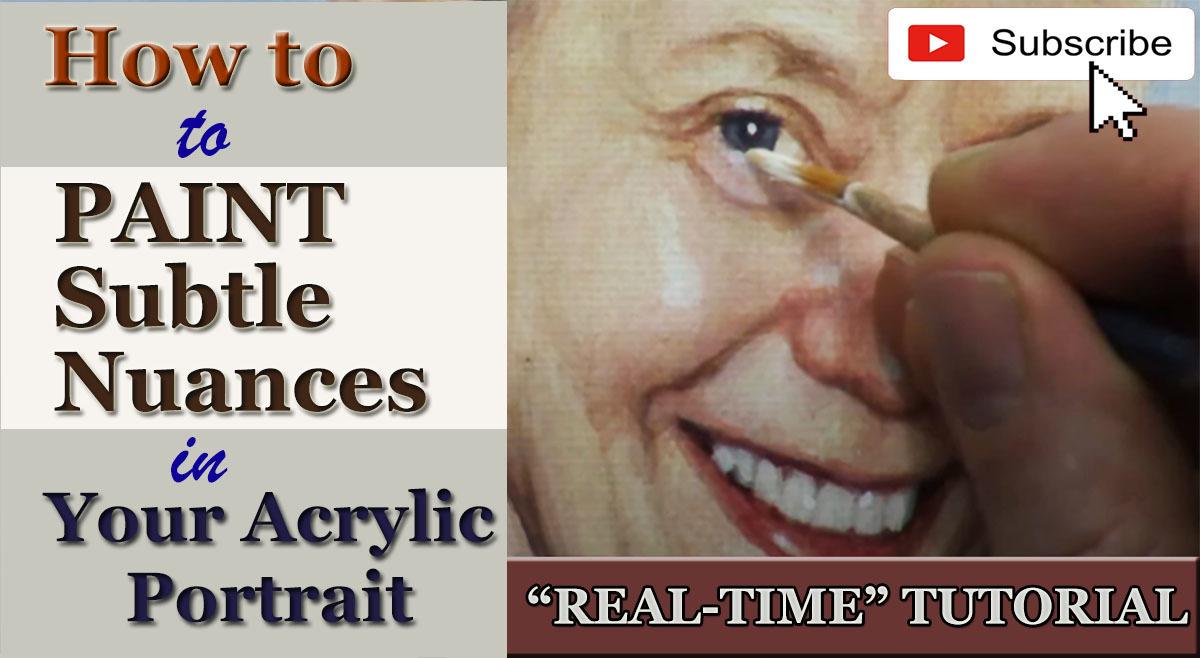
How to Paint Subtle Nuances in Your Acrylic Portrait
Discover how to add depth, light, and subtle details to your acrylic portrait, enhancing realism and making your subject come alive with nuanced highlights.
Introduction: Why Nuances Matter in Portrait Painting
Portrait painting is more than just capturing the basic features of a subject. Then to make your portrait stand out and come to life, subtle nuances small highlights, color shifts, and light reflections are essential. Because these elements help convey depth, texture, and form, making your painting more dynamic and realistic. In this tutorial, we will break down how to achieve these nuances using acrylic paint, with a special focus on adding highlights to the face, hair, and eyes of your subject.
In this case, I’ll walk through applying nuanced highlights to a 16×20 acrylic portrait, focusing on a woman’s face. These techniques can be applied to any portrait to bring out delicate details that make a big impact.
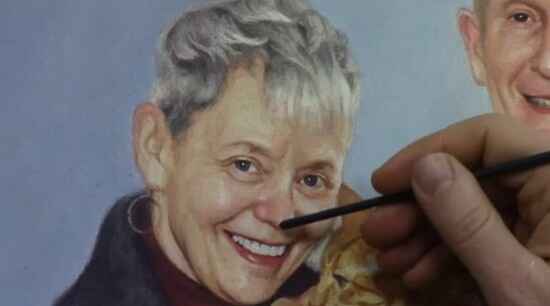
Materials Needed:
- Acrylic Paints: Titanium White, Indian Yellow, alizarine crimson
- Brushes: Size 2 round brush
- Matte Medium: For blending and creating smooth transitions
- Reference Image: Helps maintain accuracy in light and detail placement
Step-by-Step Guide: Adding Highlights and Nuances
1. Prepare Your Palette
Start by mixing your colors then of course to achieve natural, warm highlights, mix a small amount of titanium white with indian yellow. This combination softens the brightness of white while introducing warmth that complements the skin tones. And then add matte medium to create a fluid consistency, allowing the paint to glide smoothly over your canvas without overwhelming the underlying layers.
2. Highlight the Eyes
When eyes are often the focal point of a portrait so you need to begin by adding subtle highlights to the eyelid fold. When sing the fine point of a size 2 round brush, you need to carefully apply your light mixture to the upper eyelid. Because this touch of light creates dimension and reflects the light source, adding realism to the gaze.
Also, be mindful of your reference photo. Because small highlights in the right places like the inner corner of the eye or along the eyelid an make the eyes appear brighter and more expressive.
Tip: If the paint feels too opaque, mix in more matte medium. Because this technique ensures the highlight blends naturally into the surrounding areas, avoiding any harsh lines.
3. Add Nuances to the Nose
The nose is another critical area for creating form. In this portrait, the nose already has a foundation for highlights that were preserved during previous glazing steps. Then now, gently place a pinpoint highlight on the bridge and tip of the nose, where the light naturally falls. Use small, controlled strokes to build up the light gradually.
Blend the edges of this highlight with the surrounding skin tones by feathering it out with a bit of matte medium, creating a soft, diffused transition.
4. Accent the Cheeks and Chin
The next step involves bringing more light to the cheekbones and chin. These areas are key for defining the structure of the face. Use the same warm highlight mixture and lightly touch the upper areas of the cheeks. Ensure that these highlights are subtle—they should enhance the natural contours without overpowering the mid-tones.
Similarly, add a soft highlight to the chin to round out the lighting scheme. Small, strategic highlights like these give your portrait dimension and balance.
Techniques for Blending and Softening
1. Diffusing the Highlights
After applying your highlights, it’s essential to soften the transitions between light and shadow. When using a clean brush or one slightly loaded with matte medium, it gently fan out the edges of your highlights. This technique ensures that the light appears natural and seamless rather than harsh or abrupt.
For instance, after applying a highlight to the nose, use a dry brush to diffuse the edges, pulling the light into the surrounding areas. This makes the highlight feel integrated rather than sitting starkly on the surface.
2. Layering for Depth
Acrylic paint allows you to layer thin glazes to build up depth gradually. This is particularly useful for refining your highlights. Start with a soft base highlight, and as it dries, return with a slightly thicker mixture of Titanium White to emphasize the center of the light. This creates a three-dimensional effect, making certain features like the nose or cheekbones pop.
Final Touches: Enhancing Hair and Fine Details
1. Adding Highlights to the Hair
To add subtle nuances to the hair, use the same highlight mixture but with more Titanium White for contrast. Just focus on the areas where the light source hits the hair typically the top of the head and along strands that curve outward.
When you apply short, controlled strokes to simulate the texture of hair. Make sure to vary the pressure and direction of your brushstrokes to avoid a flat appearance. Highlights on the hair should complement the overall lighting scheme of the portrait, pulling everything together.
2. Refining Details on the Lips and Chin
For the final touches, go back to smaller areas like the lips and chin. A soft vertical highlight on the lower lip can create a sense of moisture and volume. Similarly, a light stroke across the chin can round out the lower half of the face. At this stage, check your reference photo again to ensure the highlights align with the overall light source.
Conclusion: Nuances Make the Difference
By focusing on subtle highlights and careful layering, you can transform a flat portrait into a vibrant, lifelike piece of art. The nuances you add—whether it’s a soft glow on the cheek or a pinpoint light in the eyes—are what make your portrait feel real. These small touches can elevate your painting and give it the professional finish you’re looking for.
Remember, practice makes perfect. Don’t be afraid to experiment with different levels of brightness and blending techniques to find the balance that works best for your subject. And always take time to step back and assess the overall effect of your nuances.
- Adding highlights to your acrylic painting
- 5 Excellent Reasons to Use Aluminum Foil
- Paint Realistic Wrinkles in Acrylic
- Painting Clothing in an Acrylic Portrait
- Paint a Cloudy Sky Acrylic
- How to add Semi-Opaque Highlights
- How to Enhance the Contrast in Your Acrylic
- How to Add Glaze to Your Acrylic Painting
- Paint Realistic Reflections on Eyeglasses in an Acrylic Portrait
- Build Up Depth on Your Acrylic Portrait Backgrounds
- How Do You Do Layers With the Glazing Technique?
- Learn How to Paint Wrinkles in Acrylic
Read more about how to paint a portrait that you can surely be proud of!
I’d love to hear your thoughts about this video. Please share it with your friends and family. Let me know if you have any further questions. I’ll greatly help you.
If you’d like to learn more, sign up for my free email tips and video class today.
Learn How to Paint Acrylic Portraits With My Free Mini-Video Course!
Thank you so much for taking the time to read this tutorial and watch the video. That means a lot to me. I hope you find it very helpful in your portrait painting.

P.S. Did you find this post helpful or encouraging? If so, send it on ahead! Let others know with the share buttons below. I’d love to hear your comments. Thank you so much! Also, do you have a question on acrylic portrait painting you’d like answered? Let me know, and I’d be happy to help!
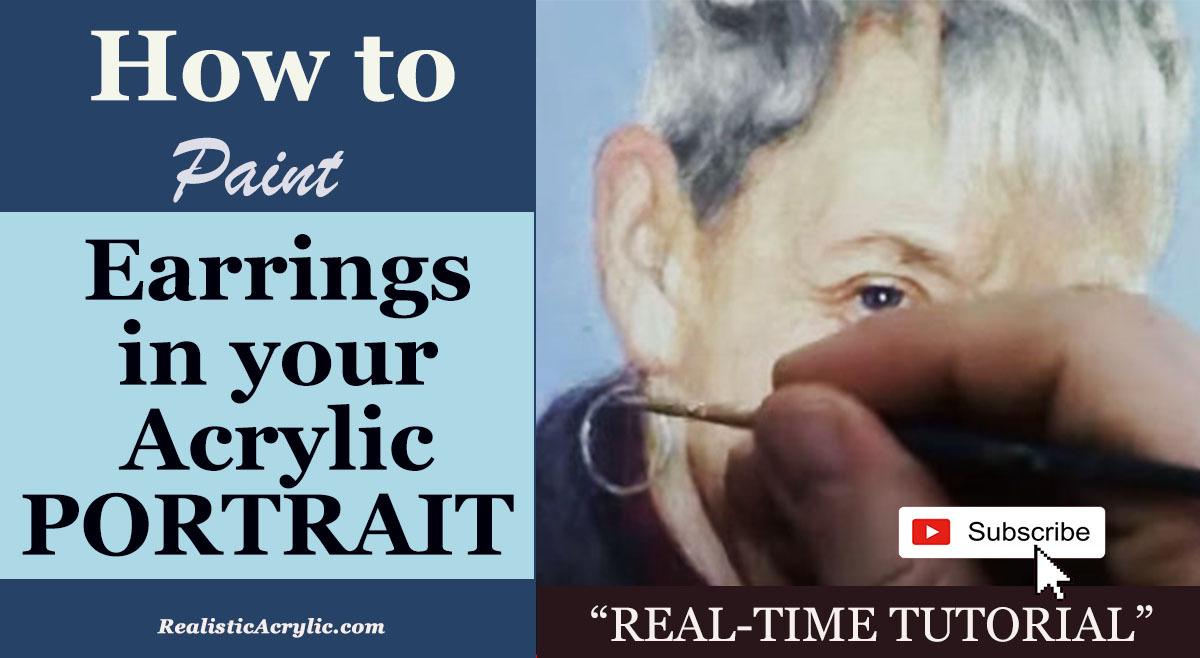
How to Paint Earrings in Your Acrylic Portrait
Learn the technique of painting realistic earrings in acrylic portraits with these easy steps
Introduction
Adding realistic details to an acrylic portrait, such as earrings, can elevate the overall quality and depth of your artwork. Painting jewelry is not just about adding a couple of dabs of paint it involves understanding the placement of highlights, shadows, and creating a smooth transition between the elements. In this tutorial, you will learn how to paint earrings in your acrylic portrait using highlights, shadows, and glazing techniques. By the end of this guide, you will have the confidence to create lifelike jewelry that complements your portraits.
Materials Needed:
- Titanium White
- Indian Yellow
- Raw Umber Dark
- Ultramarine Blue
- Alizarine Crimson
- Round Brush (size 2)
- Palette and water
Step 1: Mix Your Colors for the Base Layer
Before starting, gather your reference photo to ensure accurate lighting and color representation. In this case, a frontal flash photo was used, which plays an essential role in determining the highlights and shadows on the earring.
Begin by selecting a size 2 round brush, which is ideal for detail work. Mix titanium white with a small amount of indian yellow. The goal is to create a lighter, warm gray tone, which will serve as the base for the earring. Apply this mixture gently over the earring area, covering a significant portion to build the foundation.
Step 2: Apply a Mid-Tone Glaze
Once the base layer dries, the next step is to create a mid-tone glaze. This technique helps to integrate the light and shadow, giving the earring a more natural appearance. For the mid-tone, blend raw umber dark with the existing base mix (titanium white and Indian yellow).
Carefully apply the glaze in thin layers over the base, making sure not to overpower the light areas. Glazing provides depth and softens the transitions between different values.
Pro Tip: Ensure your glaze layers are thin and translucent. This allows the previous layers to show through, adding subtle complexity to the jewelry.
Step 3: Add Highlights
Now that the mid-tone glaze is in place, it’s time to highlight the earring to create a realistic metallic sheen. Go back to your titanium white and use a fine detail brush to apply small dabs of white on the areas where the light hits directly.
When positioning the highlights, consider the source of light from your reference photo. In this example, the highlights were placed on the upper part of the earring. You can zoom in on your reference photo to get a more precise understanding of where the light falls.
Pro Tip: It’s okay to let the highlight exceed the boundaries of the metal slightly. This will give the earring a more convincing, three-dimensional look, as if the light is reflecting beyond the earring’s surface.
Step 4: Refine the Shadows
Once the highlights are in place, the shadows are crucial to enhance the depth and make the earring stand out. Mix ultramarine blue with a touch of alizarine crimson to create a deep shadow color. This shadow should be applied under the earring where it meets the skin or the hair, depending on the reference photo.
For this step, lightly glaze the darker tones just under the highlighted areas. This step contrasts with the highlight, making the metal of the earring more vibrant and realistic. The shadow will cast a thin, dark line directly adjacent to the bright highlight, creating a striking effect.
Pro Tip: The transition between light and shadow should be smooth. Use a very small amount of paint and blend gently with your brush for a seamless look.
Step 5: Refine and Contrast the Background
To make the earring pop even more, darken the background or surrounding areas. In this case, the artist chose to slightly darken the subject’s sweater in the painting. Adding contrast around the earring helps it stand out against the background and draws the viewer’s eye to the details of the portrait.
Mix raw umber dark with ultramarine blue and lightly apply it to the background behind the earring. This subtle adjustment can enhance the overall composition and emphasize the earring’s presence in the portrait.
Final Thoughts: Evaluate and Adjust
Step back from your painting to assess the overall effect. Are the highlights and shadows properly placed? Is the earring standing out as a focal point in the portrait? Make small adjustments as needed to ensure that the earring looks natural and harmonious within the context of the entire painting.
A well-painted earring should not only be realistic but should also complement the portrait as a whole. Jewelry can bring elegance and detail to your acrylic portrait, and by following these techniques, you can ensure that it adds a professional touch to your work.
Tips and Techniques Recap:
- Use Thin Glazes: Build up layers slowly with thin glazes to add depth and softness to the transitions between light and shadow.
- Highlight Placement: Highlights should be carefully positioned according to the light source. Letting the highlight slightly exceed the boundaries adds realism.
- Smooth Transitions: Blending is key. Use a soft brush to smooth transitions between different tones, especially between the shadows and highlights.
- Contrasting the Background: Slightly darkening the surrounding area, such as the subject’s clothing or background, helps to make the earring pop.
- Evaluate and Adjust: After each layer, step back to evaluate the overall look. Make minor adjustments to perfect the balance of light, shadow, and detail.
Conclusion
Painting earrings in your acrylic portrait may seem like a small detail, but it can significantly impact the realism and professionalism of your artwork. By following the steps outlined in this tutorial, you can master the art of painting jewelry in a way that complements your portrait and adds a subtle yet powerful finishing touch.
For more tips and detailed acrylic portrait tutorials, visit realisticacrylic.com. Happy painting!
- How to Paint Foliage Using the Acrylic Glazing Technique
- How to Trace for an Accurate Portrait Sketch
- How to Paint Realistic Eyes in Your Acrylic Portrait
- How to Add Raw Umber Dark & Ultramarine Blue to Your Portrait
- How to Make Your Own Raw Umber Dark
- How to Paint Realistic Trees & Grass in Your Acrylic
- How to Block In Skin Tone Values Using Glazing Technique
- How to Paint Vibrant Reds in Your Acrylic Portrait
- How to Glaze Background Colors & More Acrylic Portrait
- How to Paint White Clothing in Your Acrylic Portrait
- How to Easily Transition from a Sketch to a Painting
- How to Block In Shading & Skin Tones in Your Acrylic
- How to Build Up Color on Acrylic Pet Portrait
- How to Build Up Form on Clothing with Acrylic
- How to Paint Dark Clothing Using Acrylic Glazing Technique
- How to Paint a 24 x 30 Acrylic With 30 People
- How to Do Smooth Shading with Acrylic
- How to Sketch an Acrylic Portrait with a Grid
Read more about how to paint a portrait that you can surely be proud of!
I’d love to hear your thoughts about this video. Please share it with your friends and family. Let me know if you have any further questions. I’ll greatly help you.
If you’d like to learn more, sign up for my free email tips and video class today.
Learn How to Paint Acrylic Portraits With My Free Mini-Video Course!
Thank you so much for taking the time to read this tutorial and watch the video. That means a lot to me. I hope you find it very helpful in your portrait painting.
Yours for Better Portraits,

P.S. Did you find this post helpful or encouraging? If so, send it on ahead! Let others know with the share buttons below. I’d love to hear your comments. Thank you so much! Also, do you have a question on acrylic portrait painting you’d like answered? Let me know, and I’d be happy to help!
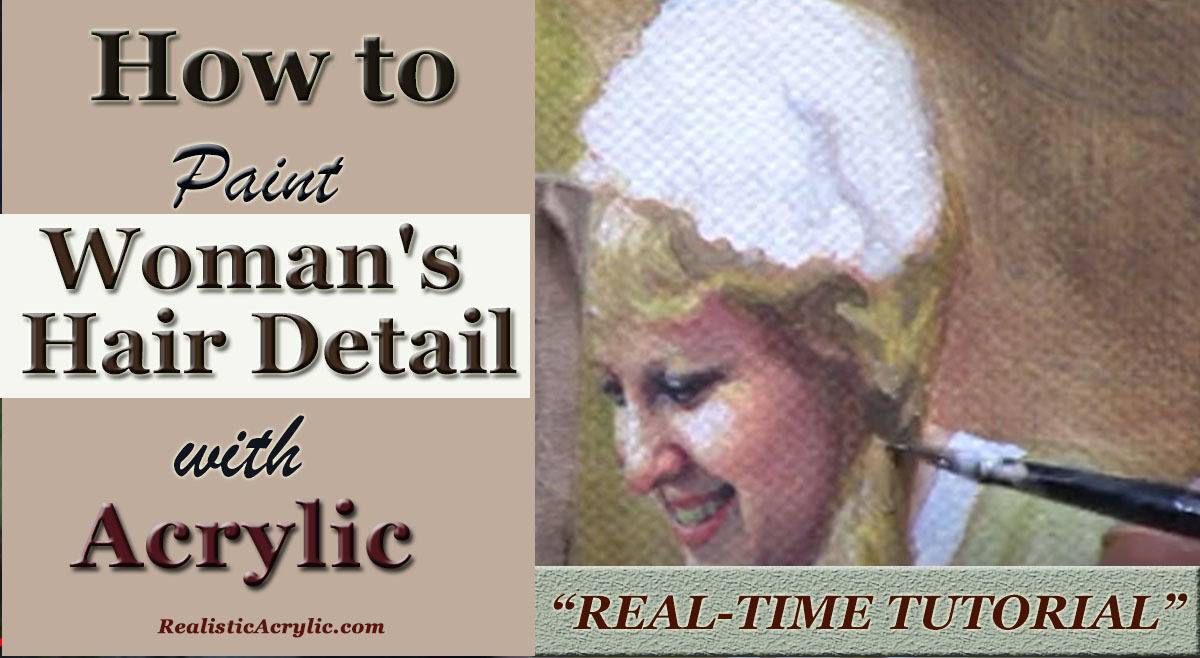
How to Paint a Woman’s Hair Detail with Acrylic
Painting realistic hair in acrylic by learning key techniques for depth, texture, and shine in this step-by-step guide.
Painting hair in acrylic can be a challenging task, especially when you’re aiming for realism. Because it requires a combination of precision, layering, and patience to achieve the right texture and shine. Then in this tutorial, we’ll explore step-by-step how to paint a woman’s hair in acrylic, focusing on creating depth, natural shading, and lifelike highlights.
Whether you’re working on a portrait or enhancing your painting skills, these techniques will help you bring hair to life on your canvas. Using a glazing method, various color mixtures, and brushwork, you can create the illusion of flowing, realistic hair.
1. Setting Up Your Palette
Before diving into painting hair, it’s essential to prepare your palette with the right colors. Hair, even when it appears as a single color, is made up of many hues that need to be layered to achieve realism. For this project, focus on the following colors:
- Raw Sienna
- Raw Umber Dark
- Titanium White
- Ultramarine Blue
- Indian Yellow
These colors provide a good foundation for both the darker shadows and lighter highlights of the hair.
2. Starting with the Base Layer
To begin, use a mixture of raw sienna and raw umber dark to block in the base color of the hair. Because this step creates the groundwork for the shadows and mid-tones. The aim here is not to focus on individual strands but to establish the overall shape and form of the hair.
As the base layer is applied, keep in mind that hair is not uniform. Some areas will be darker, especially where the light does not directly hit the hair. Mix in ultramarine blue to cool down certain areas and give the hair dimension. This mixture is particularly effective for creating shadows that contrast with the warmer tones of Raw Sienna and Indian Yellow.
3. Building Depth with Glazes
After the base layer dries, then it’s time to add depth to the hair using a glazing technique. Hence glazing involves using thin layers of translucent paint to build up color gradually. So, in this tutorial, matte medium was mixed with the paint to create these transparent layers, allowing each previous layer to shine through.
When you mix raw umber dark and titanium white with a small amount of ultramarine blue to create a soft grayish tone. Apply this mixture in the darker areas, emphasizing the parts of the hair that aren’t illuminated. Because glazes help create a smooth transition between light and shadow, giving the hair more realism.
If certain areas appear too light, you can darken them by adding another glaze of raw umber dark and ultramarine blue. It’s essential to remain patient during this process, as multiple layers may be needed to achieve the desired effect.
4. Adding Highlights
Hair shines where it catches the most light, and creating that glossy appearance is key to making hair look realistic. Use a combination of raw sienna, titanium white, and a touch of indian yellow to create a highlight color. Apply this mixture sparingly to the top sections of the hair where the light strikes.
Remember, highlights should not cover too much of the surface. Focus on smaller areas where light naturally reflects off the hair, creating that shiny, smooth effect. Use fine brush strokes to suggest individual strands while blending them into the darker layers underneath.
5. Refining Hair Strands and Texture
Once the overall structure and highlights are established, refine the texture of the hair. Use thin brushes to create subtle striations that mimic hair strands. These strokes should be fine, soft, and follow the natural direction of the hair’s flow.
Layering is vital for texture. Return to the darker areas with another glaze of raw umber dark if necessary, and then blend these shadows into the lighter sections. The combination of light, mid-tones, and dark shadows will give the hair more realism.
In addition, use ultramarine blue mixed with raw umber dark to cool down areas that are too warm. This slight temperature contrast will enhance the depth of the hair, making it look more natural and three-dimensional.
6. Creating Shadows for More Depth
Even blonde or light-colored hair can have deep shadows where the light doesn’t reach. To make these areas more pronounced, mix raw umber dark with ultramarine blue and apply it to the shadowed sections. The trick is to observe how light and shadow interact on your reference image and replicate this in your painting.
By doing this, you prevent the hair from appearing flat. Shadows give the hair its depth, making it stand out against the surrounding elements in the painting.
7. Final Touches and Adjustments
As you finish the painting, take a step back to assess the overall composition. Are the highlights bright enough? Are the shadows deep enough? Make any final adjustments by adding more glazes or highlights to enhance the dimension.
For the finishing touches, consider adding small strands of hair outside the main shape to make the hair look more natural and less “cut out.” These stray strands can be applied lightly with a thin brush, using the highlight color to make them visible against darker backgrounds.
Tips & Techniques Recap
- Use multiple glazes to build up hair color gradually. Glazing allows for more control and depth, especially in darker areas.
- Keep highlights subtle and only in areas that naturally catch the light. Over-highlighting can flatten the painting.
- Mix cool and warm tones to create more dynamic shading. Hair is not just one color; blending contrasting tones will add realism.
- Be patient with layers. Acrylics dry quickly, but that can be a benefit when working in layers to build up depth.
- Use fine brush strokes to suggest individual hair strands, but avoid over-detailing. Too many strands can make the hair look stiff.
By following these techniques, you’ll be able to paint hair that looks realistic, detailed, and full of life. Don’t be afraid to experiment with different glazing layers and color mixtures to achieve the perfect balance of depth and shine.
Now it’s your turn! Grab your acrylics and start bringing your portraits to life with beautifully painted hair.
If you’re looking for more instructional videos on how to improve your acrylic painting, visit www.realisticacrylic.com for more tutorials and check out my free courses here. .
- Adding highlights to your acrylic painting
- 5 Excellent Reasons to Use Aluminum Foil
- Paint Realistic Wrinkles in Acrylic
- Painting Clothing in an Acrylic Portrait
- Paint a Cloudy Sky Acrylic
- How to add Semi-Opaque Highlights
- How to Enhance the Contrast in Your Acrylic
- How to Add Glaze to Your Acrylic Painting
- Paint Realistic Reflections on Eyeglasses in an Acrylic Portrait
- Build Up Depth on Your Acrylic Portrait Backgrounds
- How Do You Do Layers With the Glazing Technique?
- Learn How to Paint Wrinkles in Acrylic
Read more about how to paint a portrait that you can surely be proud of!
I’d love to hear your thoughts on this video. Please share it with your friends and family. Let me know if you have any further questions. I’ll greatly help you.
If you’d like to learn more, sign up for my free email tips and video class today.
Learn How to Paint Acrylic Portraits With My Free Mini-Video Course!Thank you so much for taking the time to read this tutorial and watch the video. That means a lot to me. I hope you find it very helpful in your portrait painting.

P.S. Did you find this post helpful or encouraging? If so, send it on ahead! Let others know with the share buttons below. I’d love to hear your comments. Thank you so much! Also, do you have a question on acrylic portrait painting you’d like answered? Let me know, and I’d be happy to help!
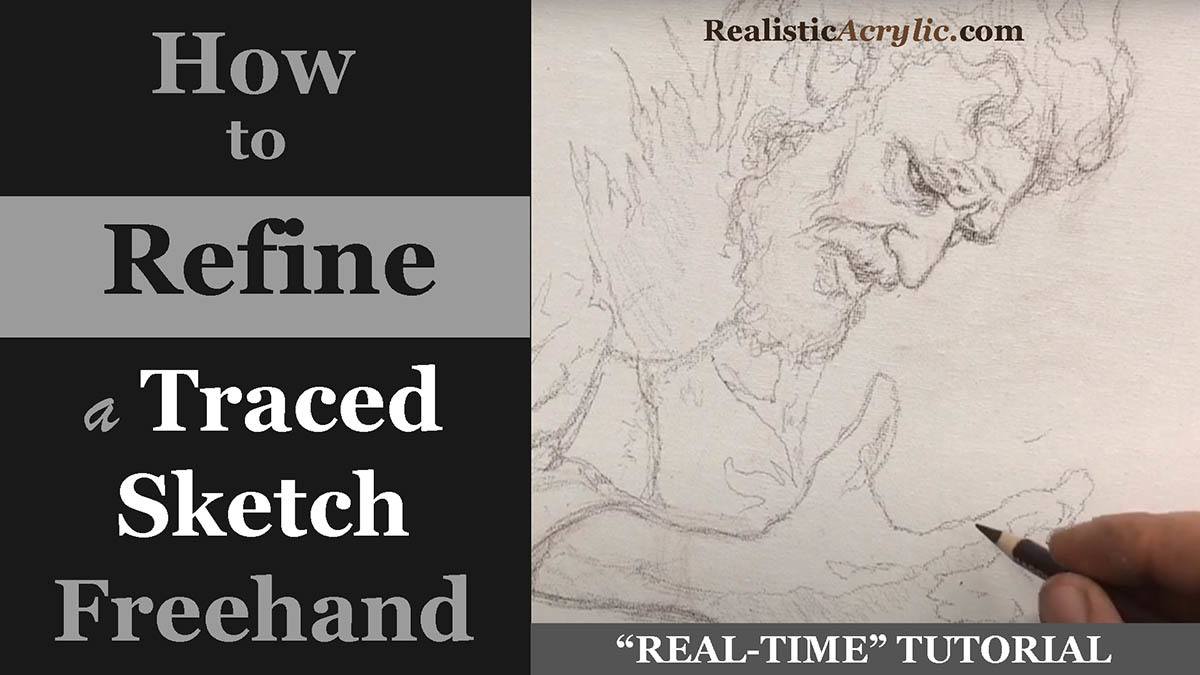
How to Refine a Traced Sketch Freehand
Learn the tips and techniques to enhance your traced sketch using freehand refinements for a more dynamic and detailed artwork.
Now what? Begin painting? Not so fast! 🙂 In this video, I’ll show you how to refine a traced sketch freehand and to make it ready to paint upon.
This is for the book of Isaiah by Russell Stendal and it’s an illustration based off this image here of a man in intercessory prayer. And originally, I did a video showing the tracing process, asking whether it’s ok to trace. And I think I answered that question, that it is—as long as you do freehand sketching and work with grids. But especially as you work with freehand sketching, which will help you to improve as an artist.
Now, I’m going to work in this sketch to show you the process of tightening up a sketch done by tracing initally and the tracing process does leave you with a lot of work left to be done. So, I’m going to show you how I’m going to add additional shading in detail and then have a sketch that I can paint on top of.
The Power of Freehand Refinements
Traced sketches are often used by artists to quickly capture the proportions and major features of a subject. However, relying solely on tracing can result in a flat, lifeless image. In this guide we will explore how to refine a traced sketch freehand, enhancing the details, adding depth, and preparing the sketch for the painting stage. By the end of this tutorial, you’ll understand how to transform a traced sketch into a dynamic, polished artwork ready for the next step.
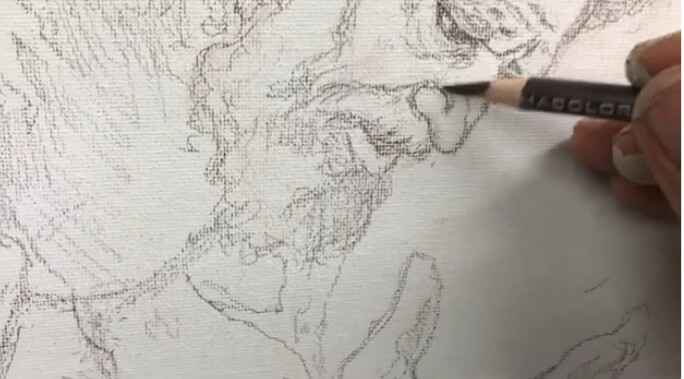
The Importance of Freehand Refinement
When an artist traces an image, they capture the basic outlines but often miss out on critical details like shadows, textures, and fine forms. This is where freehand refinement comes into play. It allows you to go beyond the rigid lines of a traced image and add life to the drawing.
In this tutorial, I’ll demonstrate how to refine a traced sketch freehand based on my work on a sketch of Isaiah or Hezekiah, which was originally traced. The traced lines were helpful to get the basic structure down quickly, but the freehand refinements were crucial for adding the depth, shading, and detail needed for an intercessory prayer-themed illustration.
Step 1: Shading and Detailing the Hands
Hands are complex and full of intricate details like tendons, veins, and shadows, which are often missed in a simple traced sketch. To refine the hands in this illustration, start by adding shading to differentiate the forms. Pay attention to areas where light hits the fingers and where shadows fall.
- Tip: Focus on the fingertips and the blood vessels to give a realistic, textured appearance to the hands.
- Technique: Use a light pencil to gently shade in the forms and increase pressure in areas where darker shadows fall, especially around the tendons and between the fingers.
Step 2: Refining Facial Features
The face is another area that greatly benefits from freehand refinement. In this particular sketch, I had traced the basic lines of the face, but it still needed significant work to look convincing. I added texture to the beard and refined the nose’s shading to give it a more three-dimensional appearance.
- Tip: When refining facial features, focus on adding shadow to areas like the nose, cheekbones, and chin. This helps to convey depth and structure.
- Technique: Create subtle distinctions between the different parts of the nose (e.g., the wing and the ball) by gently shading around the contours. Don’t hesitate to erase and rework lines if they aren’t quite right. Precision is key in this step.
Step 3: Adjusting Proportions and Textures
One of the challenges with tracing is that it can sometimes lead to slightly distorted proportions. Freehand refinement allows you to adjust these proportions for greater accuracy. For instance, I changed the hairstyle in this sketch to make it look less like myself (since I modeled for it) and more like the character I intended to depict.
- Tip: Use freehand sketching to add texture to the hair and adjust any features that seem off.
- Technique: When drawing hair, follow the natural flow of the strands, adding texture by varying the direction of your pencil strokes. This adds realism to the hair, especially in areas where light and shadow interact.
Step 4: Refining Clothing and Drapery
Clothing, especially in historical or religious illustrations, requires careful attention to the way fabric drapes and folds. In the sketch of Isaiah/Hezekiah, I added shading to the clothing to give it volume and ensure it looked appropriate for the era being depicted.
- Tip: Study the way fabric falls on the body and add shadow in the deeper folds to create a sense of weight and movement.
- Technique: Use long, fluid strokes to indicate folds, and vary your shading to show where the light hits the fabric versus where it falls into shadow.
Step 5: Adding Final Touches to the Sketch
As you refine your traced sketch freehand, don’t be afraid to go back and rework certain areas that don’t feel quite right. For example, I added a scroll to the hands to illustrate a significant moment in the story of Hezekiah, when he spread a threatening letter before the Lord and prayed for deliverance.
- Tip: Small details, such as props or background elements, can enhance the narrative of your illustration.
- Technique: Incorporate these elements with care, ensuring that they integrate naturally into the composition without overshadowing the main subject.
Final Thoughts on Freehand Refinement
Refining a traced sketch freehand is an essential step for any artist who wants to create dynamic, realistic artwork. The tracing process can save time, but it’s the freehand refinement that brings the sketch to life. By focusing on shading, texture, and proportion, you can take a basic traced image and transform it into a detailed and accurate foundation for painting.
Just like building a house requires a solid foundation, a painting requires a well-executed sketch. The time and effort you put into refining your sketch freehand will set the stage for a more successful painting, allowing you to focus on color and brushwork rather than correcting mistakes.
Conclusion
Refining a traced sketch freehand involves improving proportions, adding textures, and sharpening details to ensure the sketch serves as a strong foundation for painting. This process is especially useful in achieving realistic, dynamic compositions. Remember that tracing is just the starting point; it’s the freehand refinement that makes the difference. Keep practicing your freehand sketching skills to improve your artistic abilities and bring more depth to your work.
If you’re looking for more instructional videos on how to improve your acrylic painting, visit www.realisticacrylic.com for more tutorials and check out my free courses here.
- How to Paint Foliage Using the Acrylic Glazing Technique
- How to Trace for an Accurate Portrait Sketch
- How to Paint Realistic Eyes in Your Acrylic Portrait
- How to Add Raw Umber Dark & Ultramarine Blue to Your Portrait
- How to Make Your Own Raw Umber Dark
- How to Paint Realistic Trees & Grass in Your Acrylic
- How to Block In Skin Tone Values Using Glazing Technique
- How to Paint Vibrant Reds in Your Acrylic Portrait
- How to Glaze Background Colors & More Acrylic Portrait
- How to Paint White Clothing in Your Acrylic Portrait
- How to Easily Transition from a Sketch to a Painting
- How to Block In Shading & Skin Tones in Your Acrylic
- How to Build Up Color on Acrylic Pet Portrait
- How to Build Up Form on Clothing with Acrylic
- How to Paint Dark Clothing Using Acrylic Glazing Technique
- How to Paint a 24 x 30 Acrylic With 30 People
- How to Do Smooth Shading with Acrylic
- How to Sketch an Acrylic Portrait with a Grid
Read more about how to paint a portrait that you can surely be proud of!
I’d love to hear your thoughts about this video. Please share it with your friends and family. Let me know if you have any further questions. I’ll greatly help you.
If you’d like to learn more, sign up for my free email tips and video class today.
Learn How to Paint Acrylic Portraits With My Free Mini-Video Course!
Thank you so much for taking the time to read this tutorial and watch the video. That means a lot to me. I hope you find it very helpful in your portrait painting.
Yours for Better Portraits,

P.S. Did you find this post helpful or encouraging? If so, send it on ahead! Let others know with the share buttons below. I’d love to hear your comments. Thank you so much! Also, do you have a question on acrylic portrait painting you’d like answered? Let me know, and I’d be happy to help!
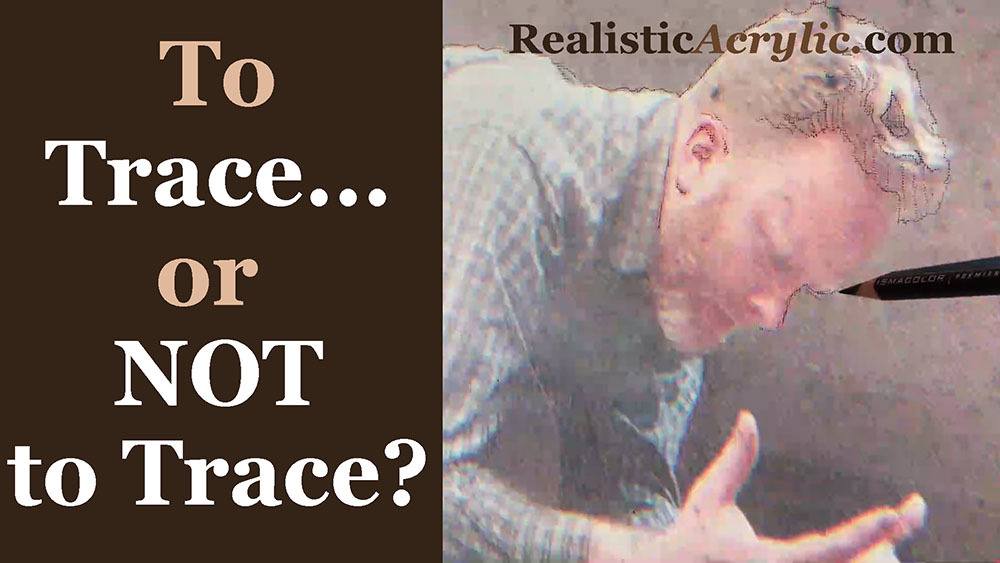
How to Trace? Is it OK to Trace as a Portrait Artist?
Let’s address the elephant in the room: tracing as a portrait artist. Is it OK? Is it cheating?
I’m going to answer that question today.
Up until COVID-19 hit, I participated in a Fall studio art tour every year. An artist on the tour, who was also the founder and coordinator for it, had some strong opinions about tracing.
“Matt, tell me you didn’t trace that sketch for the mural project you did.”
“I’m not going to lie,” I told her. “I did use a projector to get the proportions up, and then refine it freehand.”
“How could you do that? What if your client found out?”
“Well, first of all, this project was done for my church, as a gift,” I replied. “And secondly, I would be upfront with them if they asked about my process.”
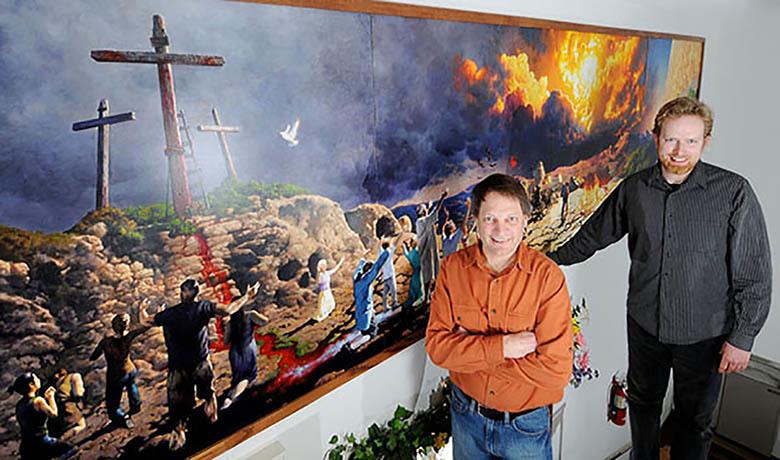
She chided me in a motherly kind of way, and I listened respectfully and smiled.
This is the first time I ever really thought about the concept of tracing as being a bad thing, at least to this degree. But is it?
I’m going to give you 5 reasons why I believe tracing is OK.
- Tracing saves time. Let’s face it. Drawing freehand, or with a grid is a time-consuming process. You have to measure, re-measure your proportions, and if you lack much drawing experience, often have to settle for eyes that are too large, noses that are unnatural, and mouths that aren’t aligned properly. I have many commissions to do, and so tracing expedites my workflow. I don’t trace all of my portraits, but for some, I choose to do so.
- Tracing helps you get accurate proportions, especially for a large painting. I had always drawn freehand and never even thought of tracing until 1999, when I did mural work with a well-known Florida muralist, Bob Jenny. He had hired me to do a series of murals depicting army medics serving in American wars at some VA hospitals. They were large—two 6′ x 30′ murals. One day, he came by to check on my work. He saw me meticulously sketching a battle scene, freehand. “We’re going to be here for months if you do it that way!” he exclaimed. “Let me show you how to do it.”And he taught me how to use an overhead projector to transfer the design up quickly and effectively.
- Tracing helps you to see distinctions in value. When you trace, especially using a projector, details become blurred and you readily notice differences in value—those distinct shapes that create the planes, the forms we see—whether they are the forehead, nose, cheekbones, or locks of hair. You can trace along the edges of those distinctions. It can be a beneficial exercise to help you in your portrait painting.
- There is historical precedent for tracing. Jan Vermeer reportedly used a camera obscura to project scenes from outside onto his surface to create exact replications of landscapes. So there is so shame. I think we can all appreciate the work of Vermeer. Art historians and art appreciators alike marvel at his skills.
- Tracing is a tool. It can be used like a contractor uses a nail gun to frame a house. The same work could be done by old-fashioned hammer and nail, but the nail-gun will do it faster. Obviously, this metaphor doesn’t translate entirely in terms of portrait painting, but the idea I’m trying to convey is that it’s just a tool.
Now, with all that said, here are some caveats on tracing.
- If you ONLY trace, and never do freehand sketching or use the grid method, your portrait painting skills will suffer. You will either stagnate, or take a very long time to progress past the beginners’ level. I get emails often from artists asking me to help them with skin tones, but because they haven’t put in the time to observe proportions and render them on the canvas, they don’t create realistic value shapes. The result is a portrait that looks falls far short of their goals. Anatomy and values must come first, skin tones after. And freehand sketching is the best way to develop it. I drew freehand for years as a child, before beginning to use acrylic in high school, and the observational skills I learned were priceless. Tracing is not cheating. But if you rely on it too much, it will cheat you, as an artist, of growth. This is why I teach my classes mostly using the grid method. It’s a good middle-of-the-road option between freehand and tracing. It helps artists create a solid sketch, so they can do a portrait they’re proud of without having to spend years getting proficient at freehand sketching. It helps them to see proportions and shapes, and then carry that confidence into their painting process!
- Tracing helps you to quickly establish proportions on your canvas, but it by itself, it’s not enough. The process often omits fine details and nuances that can only be achieved by refining your sketch with freehand sketching. In fact, tracing can flat-out distort your photo reference. In a scene, it totally obliterates the distinction between foreground and background. It can cause areas with lighter value to exceed the proper boundaries. If you want an accurate sketch to work from, you must evaluate your tracing and go back on top of it with more work, to fix mistakes and supply detail that is lacking.
- If you trace, be honest about your process. You are not obligated to tell the whole world, “I traced this!” But if your client or Facebook follower asks, did you do this freehand (most will never ask) be sure to answer them honestly and confidently about your process. If you don’t feel ashamed about it, they won’t think any less of you as an artist. Even with a traced/ projected sketch, it still takes an incredible amount of skill to do the remaining work: selecting colors, mixing them, applying them in the right places, and finishing with detail.
Here is a fun video I did on tracing. I go over a few of the ideas I shared with you above, and I also show you, if you choose to trace, how to do it, using a painting I’m doing right now as an example…
Is it OK to Trace as a Portrait Artist?
What are YOUR thoughts on tracing? Let me know below, in the comments!
- How to Paint Foliage Using the Acrylic Glazing Technique
- How to Trace for an Accurate Portrait Sketch
- How to Paint Realistic Eyes in Your Acrylic Portrait
- How to Add Raw Umber Dark & Ultramarine Blue to Your Portrait
- How to Make Your Own Raw Umber Dark
- How to Paint Realistic Trees & Grass in Your Acrylic
- How to Block In Skin Tone Values Using Glazing Technique
- How to Paint Vibrant Reds in Your Acrylic Portrait
- How to Glaze Background Colors & More Acrylic Portrait
- How to Paint White Clothing in Your Acrylic Portrait
- How to Easily Transition from a Sketch to a Painting
- How to Block In Shading & Skin Tones in Your Acrylic
- How to Build Up Color on Acrylic Pet Portrait
- How to Build Up Form on Clothing with Acrylic
- How to Paint Dark Clothing Using Acrylic Glazing Technique
- How to Paint a 24 x 30 Acrylic With 30 People
- How to Do Smooth Shading with Acrylic
- How to Sketch an Acrylic Portrait with a Grid
Read more about how to paint a portrait that you can surely be proud of!
I’d love to hear your thoughts about this video. Please share it with your friends and family. Let me know if you have any further questions. I’ll greatly help you.
If you’d like to learn more, sign up for my free email tips and video class today.
Learn How to Paint Acrylic Portraits With My Free Mini-Video Course!
Thank you so much for taking the time to read this tutorial and watch the video. That means a lot to me. I hope you find it very helpful in your portrait painting.
Yours for Better Portraits,

P.S. Did you find this post helpful or encouraging? If so, send it on ahead! Let others know with the share buttons below. I’d love to hear your comments. Thank you so much! Also, do you have a question on acrylic portrait painting you’d like answered? Let me kno
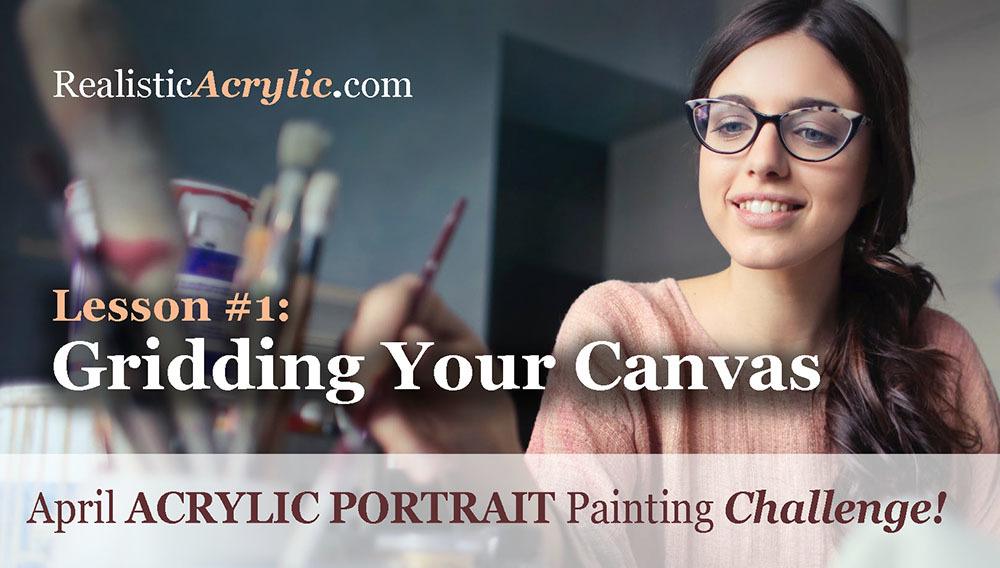
[PORTRAIT CHALLENGE] Masterclass Lesson #2: Sketching Your Portrait for a Firm Foundation
Masterclass Lesson #2 for the Acrylic Portrait Painting Challenge is open!
In this lesson, you will learn how to draw an accurate sketch that will help keep you from getting frustrated while painting. You will also be set up to create a portrait with realistic proportions, and a true likeness—where it really looks like the person you’re trying to paint.
That’s the kind of portrait you’ll be proud to show, sell, or give as an exquisite gift!
Just as a contractor wouldn’t build a house without a proper foundation, you shouldn’t paint a portrait without one either. A rock-solid sketch is the best way to establish a firm foundation for the rest of your portrait to be built upon. Take your time to do it right, and you will set yourself up for success, and avoid a lot of potential hassle later.
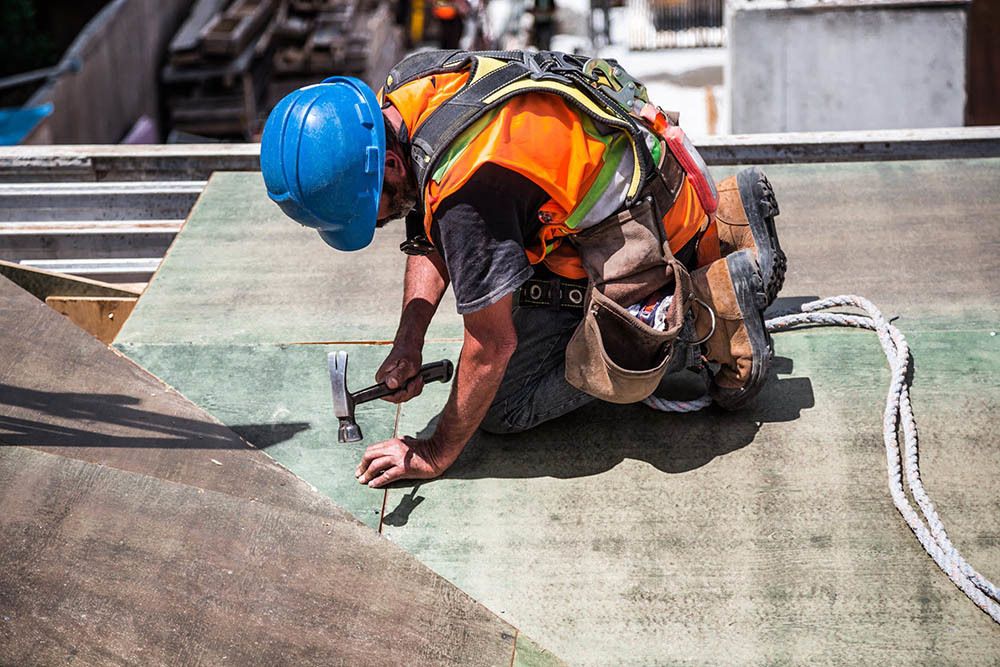
Sketching as a firm foundation for your portrait.
In our previous step, I showed you how to prepare your canvas for the sketch by creating a well-formed grid.
If you followed my instruction, you will have sealed that grid with first a layer of matte medium. Then you followed up with a roughly 50%/50% mixture of acrylic matte medium and white acrylic gesso, and let it dry for at least a couple of hours.
Now, you have a canvas that is ready to sketch upon. The matte medium/ gesso layer provides not only a barrier to the grid so you can’t erase it while sketching, but it also gives the canvas the perfect texture to sketch with a colored pencil. Back in 2017, I discovered that colored pencil erases like a dream on a properly prepared canvas. And you can seal it in without minimal loss of detail to your sketch.
Try it, and you’ll find out how fun it can be to sketch on your canvas. 🙂 You’ll never want to go back to graphite pencil again!
Another benefit: you can pick any colored pencil hue you want to match the skin tone of the subject. Remember, with my glazing technique, you will be able to see through the paint layers, down to the colored pencil until you have enough layers to cover it up. And in a few areas, even when your painting is finished, the colored pencil will shine through a bit. So pick a brown color that works best for you. Sepia, Chocolate, brown ochre, and terra cotta are all good colors for sketching.
Ready to go?
Now, before we begin…
Are you registered for the challenge?
If not, register below for FREE and I’ll send you:
- a downloadable/ printable”Welcome Kit” with a Supplies List and a Palette Color Layout Guide.
- high-resolution images of the photo we’ll be painting from for this challenge.
- each new lesson that comes out in this Masterclass series.
- a link to my private Facebook group, where you can do this challenge with other artists, get feedback and help on your portrait, and not feel alone.
REGISTER TODAY. The challenge is ongoing, something you can do at your own pace. It’s not too late to enter!
Here’s the steps to creating a masterful sketch, a firm foundation for your painting.
- Set up your tablet (Kindle, iPad, etc) or printed reference photo next to your canvas, and display the gridded reference photo. Need something to hold your tablet up? My free course shows you how to make your own Reference Photo Holder) The reference photo is your blueprint to paint a portrait from your photo. It’s what your finished painting should look like.
- Sketch the outline first. Pay attention to where you are placing your lines. Try to see the grid squares as fractions. (“the line will intersect here at 1/4 of the way up, or 1/2 of the way over, etc”
- Fill in the features, loosely: eyes, nose, mouth, etc. The eyes are the most important feature, so really make sure you capture the shapes of not only the eyes, but the eyelids and eyebrows.
- Delineate the tonal values. Shade in the areas that are darker, and pay attention to exact forms that the shadows create. Try to think of them as abstract shapes like stretched out triangles, oblong ovals, squished rectangles, for example. As you fill in these values, the planes of the face will start to emerge. You will create a convincing sense of three-dimensional form.
- Refine your sketch and add any missing detail. Step back a bit and make sure you have the proportions correct. The grid will have done the “heavy lifting” for you, by keeping your lines pretty accurate. But you might need to erase and redraw some of the features for greater accuracy. Finish up with the wrinkles in the clothing and on the hat, if needed.
Watch my in-depth Masterclass acrylic online tutorial below to see these steps in action.
After learning from this video, You’ll know exactly how to do it.
Before you watch, I want you to know that this lesson is VERY in depth. It’s one hour long! But please, make the investment in your art talent, grab a cup of coffee or tea, and watch the whole thing. If you do, I promise that you will have greater clarity on how to begin an acrylic portrait from here on out. Every portrait you do will be that much better.
Here’s the video…
Acrylic Portrait Challenge Masterclass Lesson #2: Sketching Your Portrait for a Firm Foundation
Is it done?
How accurate does it need to be? You only need to have a likeness 90% of the way there to have a fantastic sketch.
It doesn’t have to be perfect. The painted layers will dial in the likeness the rest of the way. You don’t need to make this sketch into a drawing. Meaning, you don’t need to shade in everything to the point that it looks like a finished drawing that you could hang on your wall.
No.
The sketch is for YOUR benefit…and also that of the portrait!
It doesn’t have to amaze others at this stage. It just needs to be accurate. It needs to describe the form, the contours, the three-dimensionality of the subject with line and value. You simply need to make yourself a guide so you know where to place your glazes when you segue into the painting process.
Now the painting, when it is finished, let THAT amaze others! (and you 🙂 )
There you have it! Now you know exactly how to create a great sketch for your portrait, a firm foundation you can build the rest of your portrait upon. The next step is to seal in your sketch and ease your portrait into a painting with the first few glazes.
I’ll see you in our next class! Until then have a blessed day and use that talent God gave you to its fullest!
Yours for Better Portraits,
![]()
If you found this post helpful or encouraging, would you send it on ahead? Let others know with the share buttons below. I’d love to hear your comments. Thank you so much!
Let me know if you have any questions about the challenge that I didn’t answer. Leave your question in the comments below and I’ll get back to you!
